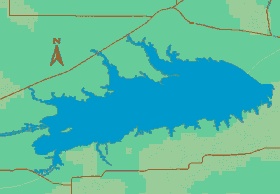Fishing
- Licenses & Regulations
- ShareLunkers
- Fish Identification
- Fish Consumption
- Texas Freshwater Fisheries Center
Water Resources
- Texas Reservoir Levels
- US Army Corps of Engineers
- Texas Water Issues
- Golden Alga
- Aquatic Vegetation
2122 Old Henderson Hwy.
Tyler, Texas 75702
(903) 593-5077
Jake Norman, Biologist
Nearby State Parks
- Cooper Lake
Doctors Creek Unit (903) 395-3100
South Sulphur Unit (903) 945-5256
Cooper Lake
Quick Links: Fishing Regulations | Angling Opportunities | Cover & Structure | Tips & Tactics
Lake Characteristics
Location: On the Middle and South Forks
of the Sulphur River, northwest of Sulphur Springs
in Delta and Hopkins counties
Surface area: 19,305 acres
Maximum depth: 55 feet
Impounded: 1991
Water Conditions
Current Lake Level
Conservation Pool Elevation: 440 ft. msl
Fluctuation: Moderate
Normal Clarity: Stained
Reservoir Controlling Authority
US Army Corps of Engineers
Cooper Dam
828 CR 4795
Sulphur Springs, Texas 75482-9745
(903) 945-2108
Aquatic Vegetation
Aquatic vegetation in the reservoir is typically unstable due to fluctuations in water level. When the reservoir is close to conservation pool elevation, and water is relatively stable, limited amounts of hydrilla and Illinois pondweed can be found in shallow areas. American lotus also occurs when the lake is full. Smartweed, buckbrush, and buttonbush also make up a substantial percentage of available habitat during periods of stable water levels.
Predominant Fish Species
Lake Records
Current
Fishing Report
Stocking History
Latest Survey Report
Lake Maps
A small map is available free of charge from the Corps of Engineers. In addition, the TPWD Inland Fisheries office offers a downloadable map  (PDF 678.8 KB) that shows some good areas to fish for hybrids and white bass.
(PDF 678.8 KB) that shows some good areas to fish for hybrids and white bass.
Fishing Regulations
All species are currently managed under statewide regulations.
Angling Opportunities
White bass and hybrid striped bass provide excellent fisheries especially in the lake's open water areas. Because hybrid striped bass do not reproduce, they are stocked annually by TPWD to maintain the fishery. Crappie fishing, in general, is fair in the lake's abundant standing timber. Crappie fishing in the early spring can be quite good along retaining walls and structural pilings when the fish are spawning. Largemouth bass occur in low numbers due to limited habitat. Though channel, blue, and flathead catfish are all present, blue catfish are most abundant and provide an excellent sport fishery.
| Species | Poor | Fair | Good | Excellent |
|---|---|---|---|---|
| Largemouth Bass | ||||
| Catfish | ||||
| Crappie | ||||
| White & Hybrid Striped Bass |
Fishing Cover/Structure
Flooded timber is found in most of the creeks, along the shoreline and in the upper half of Cooper Lake. Access to the west half of the lake is through boat lanes, sedimentation lines and openings in the timber. The main river channel is a popular area for spring fishing. Numerous small islands and fencerows also provide structure for largemouth bass anglers. Aquatic vegetation is sparse, but there are areas of floating aquatics (American lotus, water primrose), and native emergents (cattails, smartweed). The only shore development is at the state park units. There are no other boat docks or boat houses.
Tips & Tactics
In summer and early fall, schooling white bass and hybrid striped bass concentrate around main-lake points and humps. Topwater baits, jigging spoons, grubs, and lipless crankbaits are all popular. Sassy shad baits slow-rolled along the bottom and slab and flutter-spoons worked close to the bottom can generate both white bass and hybrid strikes. Other techniques for hybrids include trolling with in-line spinners and crankbaits and vertically jigging bucktail jigs. Live bait presentations for both hybrid and white bass are popular at all times of the year.
Largemouth bass anglers are most successful on this reservoir during the spring, fall, and winter months. Topwater baits such as buzzbaits, Zara Spooks, and Pop-R's are popular in the early morning and evening hours. Crankbaits and spinnerbaits are also productive fished along main-lake points and flooded timber. Popular soft plastic baits include worms, tubes, grubs, and soft-jerkbaits.
Stinkbait and cut bait work well for channel and blue catfish, while live bait is preferred for flathead catfish. Fishing with prepared catfish baits close to or within the lake’s standing timber can produce excellent catches. Try cut bait or live shad for larger blue and flathead catfish. During periods of water release catches of trophy flathead catfish below the dam are fairly common. Crappie are commonly sought in Cooper Reservoir's abundant standing timber and brush piles. Live minnows and crappie jigs are among the most popular baits used. Bank anglers are often successful fishing for crappie on the "wall" at the Heron Harbor Day Use Area in the South Sulphur Unit of Cooper Lake State Park. The Cooper Dam tailrace area also provides good bank access for a variety of sport fish when water is being released.
